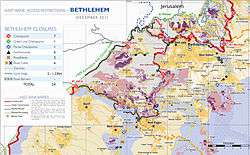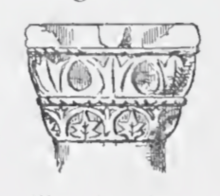Khirbet Beit Zakariyyah
| Khirbet Beit Zakariyyah | |
|---|---|
| Other transcription(s) | |
| • Also spelled | Khallet Sakarya (unofficial) |
|
Area map, showing Khallet Sakariya, 2011 | |
 Khirbet Beit Zakariyyah Location of Khirbet Beit Zakariyyah within the Palestinian territories | |
| Coordinates: 31°39′47″N 35°07′24″E / 31.66306°N 35.12333°ECoordinates: 31°39′47″N 35°07′24″E / 31.66306°N 35.12333°E | |
| Palestine grid | 160/118 |
| Governorate | Bethlehem |
| Government | |
| • Type | Village council |
| Name meaning | Khurbet Beit Skâria; The ruin of Beit Skaria (the ancient Beth Zacharias)[1] |
Khirbet Beit Zakariyyah (also Beit Zakariyyah or Khirbet Zakariah) is a small Palestinian village in the West Bank. It is located in between the larger Israeli settlements of Alon Shevut and Rosh Tzurim in the Gush Etzion region. Administratively, it is associated with Artas, Bethlehem.
History
The village may be the site of the Battle of Beth Zechariah between the Jewish Maccabeans and Selucid Greek forces during the Maccabean revolt against the Seleucid Empire, in the year 162 BCE.[2][3] However, other sources place the battle at Zekharia/Az-Zakariyya in modern Israel.
Three rock-cut burial caves, dating to the 1st century BCE have been excavated, and pottery fragments from the 1st century BCE were found.[4]
In the Byzantine period an important church was located here, which appears on the Madaba map. Since then a mosque, going by the name Nabi-Zakariah, has been built on the site of the church. Some of the ruins of the church are preserved beneath the mosque. In general, houses in the village are built on top of ancient ruins and caves.
During the Crusader era, Casale Zacharie, like nearby al-Khidr, probably was a Christian village, and it was granted with al-Khidr to the church of Bethlehem between c. 1155 and c. 1186.[5]
Pottery fragments from the Mamluk era have also been found.[4]
Ottoman era
In the Ottoman census of 1538-1539, Bayt Dhakariyya was located in the nahiya of Halil,[6] while in 1557, it was noted that the village revenues went to an Imperial imaret in Jerusalem.[7]
In 1852, Edward Robinson noted Beit Sakarieh “on an almost isolated promontory or Tell, jutting out northwest between two deep valleys; and connected with the high ground south by a low neck between the heads of those two valleys."[8]
In 1863, Victor Guérin found the village “almost entirely abandoned, and consists of a confused mass of little houses, very badly built, and most of them falling into ruin. Only a few are still inhabited by a dozen fellahin, who find themselves busy beating their grains on ancient areas. Here and there we meet cemeteries dug in the rock. A small mosque contains, it is said, a tomb, which is no longer visible.“ “At the entrance of this sanctuary, I notice two column s which seem to come from a Byzantine church; The capitals, in fact, represent species of baskets of rushes interwoven like the meshes of a net.“[9]
An Ottoman list from about 1870 notes a Muslim Weli, dedicated to a Sheikh Zakarja, located under a large tree. Several cisterns were also noted, and that the old Roman road to Jerusalem passed by.[10]
The Palestine Exploration Fund's Survey of Western Palestine visited in 1873 and noted: "From the main Roman road on the south a path leads to this ruin, situate on the brow, overlooking deep valleys on the east and north. Beside the path is a square foundation about 50 feet side, of roughly-dressed stones. The remains on the hill-brow are those of a large modern village, with more ancient foundations. One wall consists of stones 4 1/2 feet long, 2 feet high, roughly dressed. There is also a mosque, with a portico on the west, sunk below the surface. On the north side of this portico a pillar is placed with a capital of basket-work (see illustration), like the eighth century Byzantine capitals. The shaft is 2 feet diameter. The mosque door was shut ; perhaps it may represent the site of the church which once stood at this place. [..] Drafted stones with a rough boss were also found, and another capital, apparently Byzantine. To the west of the site are rock-cut tombs, now blocked. A tree grows over the Mukam, or mosque."[11]
Modern era
The original four communities of Gush Etzion were founded around Beit Zakariah in the 1940s. In late 1947, following the passage of UN resolution 181 calling for partition of Palestine into Jewish and Arab states, tensions in the area rose, and Beit Zakariah was the very first Arab village in all of Palestine to be abandoned by its inhabitants.
On January 14, 1948, Arab forces led by Abd al-Qadir al-Husayni attempted to capture the strategic hill of Beit Zakariah, and thus to split Gush Etzion into two in preparation for its total conquest. However, Jewish forces defeated them in the Battle of 3 Shevat. The defeat had strategic implications for all of Palestine - as a result, Husseini cancelled his plans to attack Jewish communities, and focused on attacks on the roads.[12][13]
Gush Etzion was finally captured in May 1948. When a cease-fire was reached between Israeli and Jordanian forces in 1949, the area became part of the West Bank. After the Six-Day War in 1967, the Gush Etzion settlements were reestablished. At some point after January 1948, the Arab residents of Beit Zakariah returned to their homes. They now form a small Arab minority within the Gush Etzion bloc.[14]
References
- ↑ Palmer, 1881, p. 302
- ↑ Schürer, Millar, and Vermes, 2014, p. 166
- ↑ Beth-zacharias, International Standard Bible Encyclopedia
- 1 2 Peleg and Feller, 2004, Rosh Zurim
- ↑ Pringle, 1993, p. 204
- ↑ Toledano, 1984, p. 289, has Bayt Dhakariyya at location 35°07′00″E 31°40′05″N.
- ↑ Singer, 1994, pp. 26, note #6; 165
- ↑ Robinson and Smith, 1856, pp. 283-284
- ↑ Guérin, 1869, pp. 316-319
- ↑ Socin, 1879, p. 148
- 1 2 Conder and Kitchener, 1883, SWP III, p. 108
- ↑ http://www.news1.co.il/Archive/002-D-109259-00.html
- ↑ Yohanan Ben-Yaakov, The Mountain Division, the Lamed-Heh Story, Israel Defence Ministry press, 2008, page 44
- ↑ Aharon Dolev, Rosh Tzurim: the petition was denied, Maariv, 7 November 1980
Bibliography
- Conder, Claude Reignier; Kitchener, H. H. (1883). The Survey of Western Palestine: Memoirs of the Topography, Orography, Hydrography, and Archaeology. 3. London: Committee of the Palestine Exploration Fund.
- Guérin, Victor (1869). Description Géographique Historique et Archéologique de la Palestine (in French). 1: Judee, pt. 3. Paris: L'Imprimerie Nationale.
- Palmer, E. H. (1881). The Survey of Western Palestine: Arabic and English Name Lists Collected During the Survey by Lieutenants Conder and Kitchener, R. E. Transliterated and Explained by E.H. Palmer. Committee of the Palestine Exploration Fund.
- Peleg, Yuval; Feller, Yaron (2004-05-31). "Rosh Zurim" (116). Hadashot Arkheologiyot – Excavations and Surveys in Israel.
- Pringle, Denys (1993). The Churches of the Crusader Kingdom of Jerusalem: A-K (excluding Acre and Jerusalem). I. Cambridge University Press. ISBN 0 521 39036 2.
- Robinson, Edward; Smith, Eli (1856). Later Biblical Researches in Palestine and adjacent regions: A Journal of Travels in the year 1852. London: John Murray.
- Schürer, Emil; Millar, Fergus; Vermes, Geza (2014). The History of the Jewish People in the Age of Jesus Christ. A&C Black. ISBN 1472558278.
- Singer, Amy (1994). Palestinian Peasants and Ottoman Officials: Rural Administration Around Sixteenth-Century Jerusalem. Cambridge University Press. ISBN 9780521476799.
- Socin, A. (1879). "Alphabetisches Verzeichniss von Ortschaften des Paschalik Jerusalem". Zeitschrift des Deutschen Palästina-Vereins. 2: 135–163.
- Toledano, E. (1984). "The Sanjaq of Jerusalem in the Sixteenth Century: Aspects of Topography and Population". Archivum Ottomanicum. 9: 279–319.
- van de Velde, Carel Willem Meredith (1858). Memoir to Accompany the Map of the Holy Land. Gotha: Justus Perthes. (p. 166)
External links
- Survey of Western Palestine, Map 17: IAA, Wikimedia commons
- Beit Sakariya Village (Fact Sheet), ARIJ
- Beit Sakariya Village Profile, ARIJ
- Beit Sakariya Areal photo, ARIJ
- The priorities and needs for development in Beit Sakariya village based on the community and local authorities’ assessment), ARIJ
- Land Grab continues in Bethlehem District, Posted: 09/03/04, POICA
- Threats of House Demolitions in Beit Sakariya Hamlet, 10/04/2007, POICA
- When Settlers Attack, Thejerusalemfund


